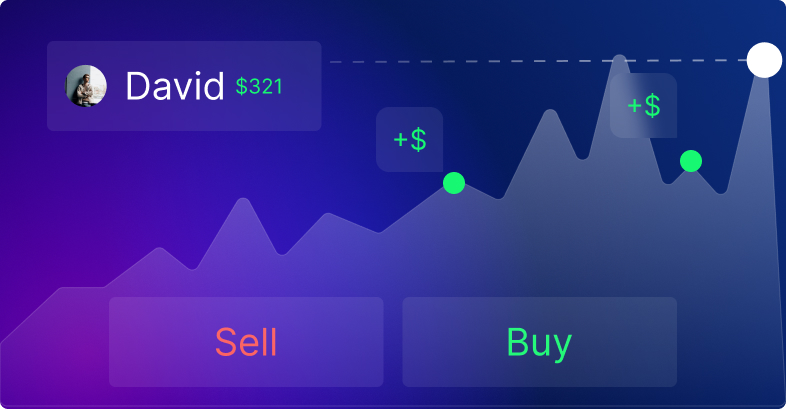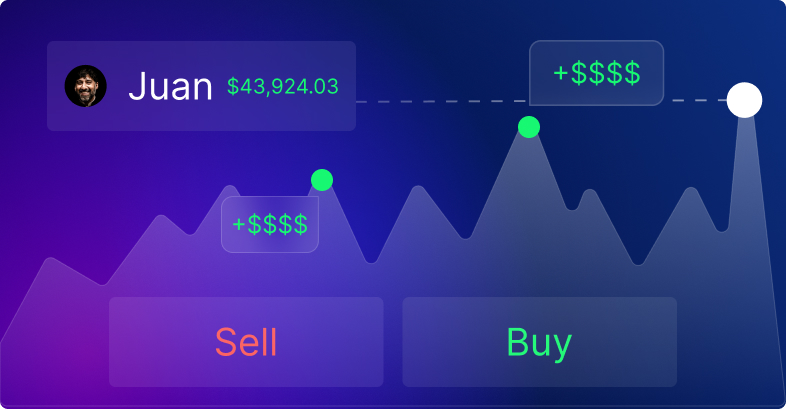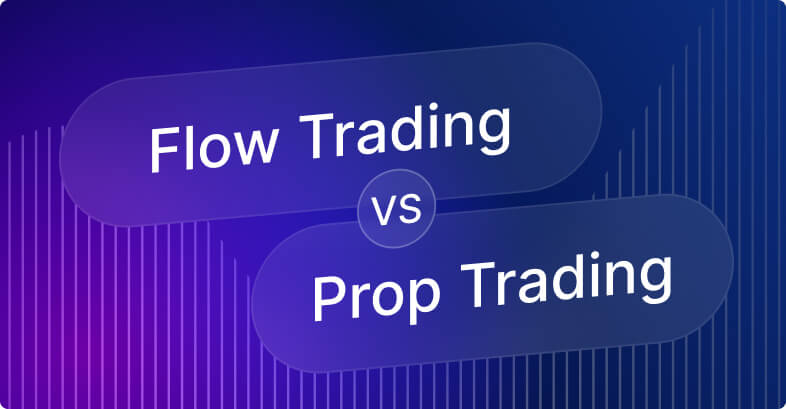Flow Trading vs Prop Trading
The dynamic world of finance is one where traders are continually faced with decisions that could either pave the way to profit or lead to potential losses. Understanding the nuances of different trading strategies is fundamental, particularly when it comes to flow trading and prop trading. These strategies are not just about buying low and selling high; they are rooted in distinct principles that serve various types of market players—from individual traders at a desk to large investment banks and hedge funds.
While both strategies involve the use of capital and financial instruments like stocks, bonds, and derivatives, they differ significantly in purpose, risk, and approach. Flow trading operates within the confines of a firm’s client requests, facilitating transactions to earn a spread or commission without assuming the risk of the market. On the other hand, prop trading involves traders using a firm’s own money to trade on the basis of their market predictions, aiming to make a direct profit from market movements.
We will explore these strategies in this article, helping you understand which approach might best align with your investment goals and risk tolerance. We’ll touch on the conditions under which each strategy thrives, and discuss the tools and skills required to succeed. It doesn’t matter if you’re currently working at an investment bank, a prop trading firm, or even trading as an independent trader, understanding these concepts can significantly influence your trading outcomes and career.
Understanding Flow Trading

Flow trading is a financial strategy where a firm trades financial instruments like stocks, bonds, currencies, and commodities on behalf of its clients, using the clients’ funds rather than its own. The goal of flow trading is mainly to provide liquidity in the markets and facilitate client transactions, making money through commissions and the bid-offer spread. This type of trading is crucial for investment banks as it allows them to generate profits while serving as intermediaries in client transactions.
Typically, flow trading finds application in situations where a firm acts as a market maker, quoting both buy and sell prices for financial instruments to profit from price differences. For example, a flow trader might handle a large volume of orders in various securities, ensuring there is enough liquidity in these markets for investors to buy or sell their shares at any given time. This setup is particularly beneficial in markets where swift execution and price stability are valued, such as with heavily traded stocks or currencies.
Understanding Prop Trading

Proprietary trading, also known as “prop trading,” involves financial firms using their own funds to engage in trading activities, as opposed to using their clients’ capital. This approach allows these institutions to keep all the profits they generate from market movements, without having to rely on earning commissions by trading based on client activities. Prop trading can also encompass a diverse range of financial instruments including stocks, bonds, commodities, and derivatives.
Prop trading is extensively utilized by firms to capitalize on market opportunities that they identify using advanced tools and analytics. For example, prop traders might use strategies like global macro-trading, merger arbitrage, or volatility arbitrage to exploit market inefficiencies. These strategies allow them to take significant positions in various securities, aiming to profit from predicted market movements. Furthermore, prop trading desks are often separated from other trading units within a firm to avoid conflicts of interest and to focus purely on profit-making from market activities
Prop Trader vs Flow Trader: Advantages and Disadvantages
Both approaches come with its unique set of advantages and disadvantages. Starting with flow trading, the primary advantages include a stable income, lower risk, and high salaries. Since flow traders make money primarily through commissions on the trades they execute for their customers, their income can be more predictable and less susceptible to market volatility. Flow trading also requires less start-up capital compared to proprietary trading.
Of course, there are also some drawbacks. The profit potential is generally limited to the fees generated from the spread between the buying and selling prices, and the strategy’s success heavily depends on the volume of customer activity. If client orders are sparse, the opportunities to make a profit will be correspondingly limited. This dependence on clients means that flow traders must continuously attract and maintain a solid client base to sustain their operations and stay competitive.
On the other hand, proprietary trading offers the potential for higher profits since traders can take full advantage of market movements and are not limited to earning commissions. Prop traders are free from client dependencies, allowing them greater flexibility to employ various trading strategies based on the entry and exit opportunities they find—from simple stock trades to complex derivatives trading. This independence inevitably enables prop firms to tailor their approaches based on their market predictions and risk appetite.
Yet, the freedom of proprietary trading also comes with significant risks. The potential for high returns comes with a corresponding potential for sizeable losses, especially when leveraging complex and high-stake strategies. Additionally, prop trading often requires a considerable amount of initial capital to cover potential losses and to invest in top notch trading technologies and analytics tools. The complexity of strategies used and market conditions also demand a high level of expertise, continuous market analysis, and emotional strength to handle crises and manage stress, adding to the operational challenges of proprietary trading.
What Makes You a Flow Trader or a Prop Trader
Choosing between flow trading and prop trading will largely depend on the trader’s experience level, risk tolerance, performance, and resources. We can touch on this subject by considering experience levels, for instance.
- Beginner Traders: Flow trading is ideal for fresh-out-of-college people who aspire to get into finance and join other professional traders at banks due to its lower risks and modest capital requirements. It allows new traders to gain experience in the intricacies of market making without the high stakes of market speculation.
- Experienced Traders: Proprietary trading suits experienced traders who are looking for methods to boost their earnings and perform independently from customer activity. It requires a deep understanding of market trends and risk management.
- Institutional Traders: For institutional traders, such as those trading for hedge funds, banks, or exchanges, prop trading is often more appropriate due to the potential for substantial profits. Institutional traders typically have access to significant capital and advanced trading technologies, allowing them to implement complex strategies across various markets. The ability to maneuver large amounts of capital and the autonomy in decision-making in prop trading suit the goals and structure of institutional trading operations.
- Other Traders: Freelance or independent traders need to consider their capital availability and risk appetite. Those with limited capital might start with flow trading to build their resources and experience. On the other hand, well-capitalized traders looking for independence and maximum profit opportunities might lean towards prop trading, especially if they have a robust risk management framework in place.
Strategy Implementation in Prop Trading vs Flow Trading
Each strategy may come with its own distinct prerequisites that align with its operational needs. Whether you’re planning on moving towards prop trading or flow trading, you better understand what each style requires in terms of capital, skills, and tools.
Flow Trading:
- Capital: Flow trading generally requires less start-up capital than prop trading because the firm uses client funds to execute trades, rather than its own capital. As a flow trader hired by a financial institution, you will also be rewarded monthly based on a fixed salary plus an additional value based on how you perform.
- Skills: Essential skills for flow traders include a strong understanding of market mechanics, excellent customer service abilities, quick decision-making capabilities, and also have a somewhat salesman skills. Flow traders need to respond quickly to client trades and stay vigilant on market conditions.
- Tools: The primary tools for flow trading include sophisticated trading and order management systems that can handle high volumes of trades efficiently. Access to real-time market data and analytics software also helps flow traders monitor markets and manage multiple client accounts and assets.
Prop Trading:
- Capital: Prop trading occurs when a firm finds profitable opportunities given market conditions. They don’t deal with customers’ capital, meaning they’re often trading using their own money, thus requiring a significant start-up investment. In the real world, this start-up capital is not only used to place trades but also to cover potential losses, which can be substantial given the high-risk nature of financial markets.
- Skills: The content inside a prop trader’s skill set must be filled with advanced analytical abilities, including being able to perform complex quantitative analyses and a deep understanding of various trading strategies, such as statistical arbitrage and global macro trading. Risk management is also an important skill, as prop traders must manage the substantial risks associated with their activities.
- Tools: Prop trading desks are equipped with some of the most advanced trading software available, including algorithms for automated trading, risk assessment models, and tools for in-depth market analysis. High-performance computing power to process trades quickly and efficiently is also crucial, given the often volatile environments in which they operate.
Measuring Effectiveness in Proprietary Trading and Flow Trading
The effectiveness of flow trading and prop trading may vary significantly depending on market conditions, and each strategy has its distinct advantages and challenges.
Flow trading tends to perform well in stable and a bit more predictable markets where the primary revenue comes from the bid-offer spread and commissions. The effectiveness of flow trading can diminish in highly volatile, illiquid, or extremely unpredictable markets, as it relies on consistent client activity to generate profits. Flow traders must be adept at managing these conditions by adjusting their strategies to maintain profitability without taking on excessive risk.
Prop trading is often more adaptable to different market conditions due to its independence from client-driven flows. It can capitalize on market volatility to achieve high returns, employing data-driven strategies and volatility arbitrage. However, this comes with higher risks and worries, as prop trading involves using the firm’s capital to make speculative bets on market directions. The success of prop trading is heavily dependent on the traders’ ability to manage these risks and adapt to rapid changes in the market.
Both trading types rely on specific metrics to measure success and adapt strategies. Prop trading firms often use the Sharpe Ratio to evaluate the risk-adjusted returns of their strategies, aiming to maximize returns per unit of risk taken. Meanwhile, maximum drawdown is a critical metric for understanding potential losses and the sustainability of a strategy under adverse conditions. These metrics help firms refine their approaches and ensure long-term viability by balancing risks with potential rewards.
Conclusion
Looking ahead, the prospects for flow trading and prop trading are shaped by evolving market trends and technological advancements. Flow trading is expected to continue benefiting from automation and advanced data analytics, enhancing the efficiency and speed of transactions. However, the increasing adoption of these technologies could also push margins lower, as competition intensifies among firms to offer quicker and cheaper execution services. On the other hand, prop trading stands to gain from the heightened market volatility and the global economic shifts, presenting more opportunities for arbitrage and speculative gains. Yet, this comes with greater scrutiny and regulatory challenges that could reshape how prop firms operate.
Overall, while flow trading offers stability and lower risk, making it suitable for entities that prefer consistent income and risk-averse strategies, prop trading suits those seeking higher returns and who possess the capital and risk appetite to manage volatile market conditions. Each strategy has its merits and is influenced by distinct market dynamics, requiring traders and firms to carefully consider their goals, resources, and tolerance for risk before choosing the path that aligns best with their strategic objectives.
And if you’re interested in becoming a prop trader, the article The Essentials of Proprietary Trading: Understanding How It Works by Nikita Mazikov is a great source to explore in-depth the intricacies of proprietary trading and understand how well this path might suit you.



